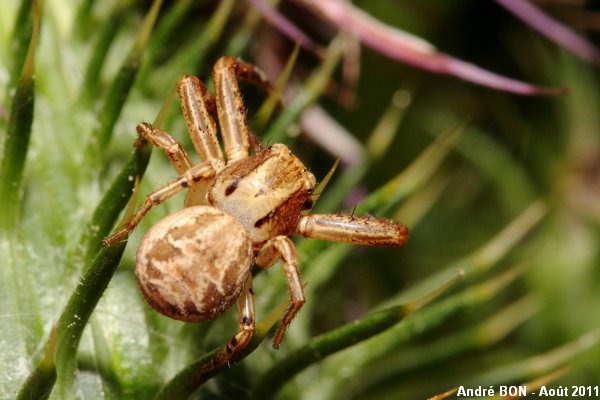
| Xysticus of the cristatus group (Xysticus (cristatus) sp. (Clerck, 1757)) |

|
|
Scientific name: Xysticus (cristatus) sp. (Clerck, 1757) Common name: Xysticus of the cristatus group Other names: This group includes Xysticus cristatus Clerck, 1757, Xysticus kochi Thorell, 1872 and Xysticus bifasciatus C. L. Koch, 1837. French name: Order: Araneae Family: Thomisidae Size: Females: 6 to 10 mm; males: 4 to 7 mm. Biotope: Flowers and low growing vegetation, low branches on trees and shrubs. Web: No web. The spiders of the Xysticus genus are used to hunting by sitting in wait on the low growing vegetation. Observation period: April to September. Geographic area: Palaearctic region for Xysticus cristatus and Xysticus bifasciatus. Europe except extreme northern regions and Central Asia for Xysticus kochi. |
The spiders of the Xysticus genus are small-sized crab spiders characterized by two well developed fore leg pairs, a cephalothorax slightly smaller than the abdomen and often showing a pale median band. The edges of the cephalothorax show a dark line above a pale line. The abdomen is generally flattened. It is enlarged at the rear and often shows a dark leaf-shaped or pagoda-shaped median pattern. The four median eyes form a trapeze. It is square-shaped or wider than high on the spiders of the Xysticus genus, meaning that the median eyes are not laterally very close. The spiders of the Ozyptila genus, which are a smaller size and generally observed on the ground, are very similar to those of the Xysticus genus. However the median eyes are laterally closer to each other so that the trapeze shape is higher than wide. There are many similar species (about 360 worldwide, 71 in Europe) and it is very difficult to tell them apart without a microscopic exam of the genitalia. You can recognize female Xysticus of the cristatus group with the following points: - The cephalothorax shows a broad white central longitudinal band marked with a darker triangle ending with a sharp black point at the back. The cephalothorax's edges are darker and may show a paler area next to the abdomen. - The abdomen shows a well drawn pagoda roof shaped mark. - The legs are light coloured with very few marks. Femora of legs I show three large dark spots at the base of the femoral spines. Legs IV show several dark irregularly arranged patches. |
| [To know more about the Xysticus of the cristatus group] [Top] |

|
All the criteria, previously mentioned to tell Xysticus of the cristatus group apart, are visible on this picture. |